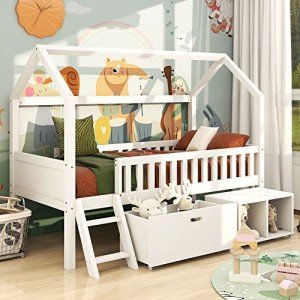The Ultimate Guide to Bunk Beds for Children: Safety, Styles, and Benefits
When it pertains to styling a kid's space, parents frequently deal with the double difficulty of making the most of space while ensuring comfort and functionality. Bunk beds have actually become a popular solution that attends to these needs, using not simply sleeping plans but also contributing to a room's visual. In Bunks , we will explore various aspects of children's bunk beds, concentrating on their benefits, security functions, styles, and factors to consider for moms and dads contemplating this purchase.
Table of Contents
- Advantages of Bunk Beds
- Security Features to Consider
- Types of Bunk Beds
- Style and Style Options
- Maintenance Tips
- Frequently Asked Questions (FAQs)
1. Advantages of Bunk Beds
Bunk beds offer many advantages for children and their parents. Here are some crucial benefits:
- Space-Efficiency: Bunk beds are an exceptional solution for smaller spaces. By stacking one bed on top of another, more floor space is offered for play, storage, or research study locations.
- Cost-efficient: When children share rooms, bunk beds can lower the need for purchasing two different beds, hence saving cash.
- Cultivates Social Interaction: Bunk beds can assist siblings or buddies bond by sharing a space, producing chances for social advancement.
- Fun Factor: The principle of sleeping "up high" adds a spirited element to bedtime, making the transition to sleeping alone much easier for some children.
- Versatile Design: Bunk beds come in various designs, colors, and designs to match any space theme, enabling for personalization that shows the child's personality.
2. Safety Features to Consider
Safety is paramount when it pertains to kids's furniture, particularly when it comes to bunk beds. Here are some vital safety functions to assess:
| Safety Feature | Description |
|---|---|
| Sturdy Construction | Frames made from strong wood or metal are preferred. |
| Guardrails | Ought to be at least 5 inches high and extend along both sides of the upper bunk. |
| Ladder Design | Ensure ladders are safely connected and have non-slip steps. |
| Bed mattress Size & & Fit | Should fit comfortably within the frame to prevent gaps. |
| Weight Limit | Constantly stick to the manufacturer's weight limit recommendations. |
3. Kinds Of Bunk Beds
Bunk beds are available in numerous styles, dealing with different needs, choices, and space sizes. Here are some typical types:
- Standard Bunk Bed: The a lot of standard type, with one bed on top of another.
- Loft Bed: Features a high upper bed with space below for a desk or play area.
- Futon Bunk Bed: Combines a top bunk with a futon on the bottom, providing versatility for seating and sleeping.
- L-Shaped Bunk Bed: This design has the top bunk set at a perpendicular angle to the bottom, creating a little corner area.
- Triple Bunk Bed: Accommodates three children utilizing stacked beds, ideal for big households or slumber parties.
4. Style and Style Options
When it pertains to choosing a design for children's bunk beds, the alternatives are essentially unlimited. Here are some popular styles:
- Traditional Style: Often made of wood, these bunk beds include ornate information and are best for timeless or rustic-themed spaces.
- Modern Style: Characterized by tidy lines and minimalist designs, contemporary bunk beds can be made from metal or wood.
- Themed Bunk Beds: Some brand names use bunk beds formed like castles, cars and trucks, or play houses, making bedtime less of a chore.
- Convertible Bunk Beds: These can be separated into two specific beds, providing versatility as children grow.
- Colorful Options: Bunk beds in dynamic colors can include a sense of pleasure and playfulness to any room.
5. Upkeep Tips
Preserving a bunk bed is essential for longevity and safety. Here are some pointers:
- Regular Inspections: Check for loose screws or bolts every few months and tighten them as needed.
- Cleaning: Wipe down frames routinely to avoid dust accumulation; consider utilizing a vacuum for hard-to-reach locations.
- Bed mattress Care: Rotate bed mattress regularly and utilize protective covers to lengthen their life.
- Expect Wear and Tear: Look for any indications of damage in the wood or metal and think about changing parts if necessary.
- Teach Kids Safety Rules: Encourage kids to use ladders properly and guarantee they comprehend the security features of their bed.
6. Frequently Asked Questions (FAQs)
Q1: What age is suitable for oversleeping a top bunk?
A1: Typically, children aged 6 and older are recommended for upper bunk sleeping, as they have the essential motor abilities to climb up safely.
Q2: Do bunk beds include a mattress?
A2: Most bunk beds are offered as frames just, so you will need to purchase mattresses independently. Make Kids Bunk Bed that the bed mattress fits the frame snugly.
Q3: Can bunk beds be separated later on?
A3: Many styles enable conversion into two individual beds, providing versatility for future requirements.
Q4: How can I guarantee my child's security on a bunk bed?
A4: Comply with security requirements and ensure guardrails, a sturdy frame, and a secured ladder remain in place.
Q5: Are there weight limitations on bunk beds?
A5: Yes, always examine the maker's requirements regarding weight limitations to make sure safety.
Bunk beds for children can serve several functions while making sure safety and design. With diverse designs and designs offered on the market, moms and dads can discover an unit that not just optimizes bedroom space but also shows their kid's distinct tastes. Similar to any furnishings, comprehending safety features, upkeep, and how they suit a kid's lifestyle will ensure that these beds remain a practical furniture solution for many years to come.
Through careful consideration and adherence to security guidelines, bunk beds can offer a lasting, fun, and practical sleeping option that kids love.

